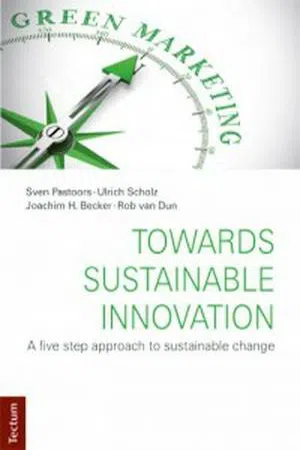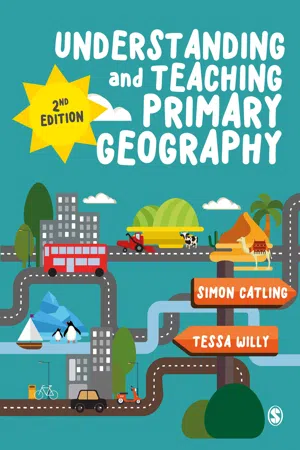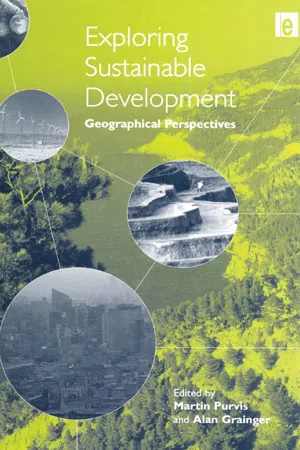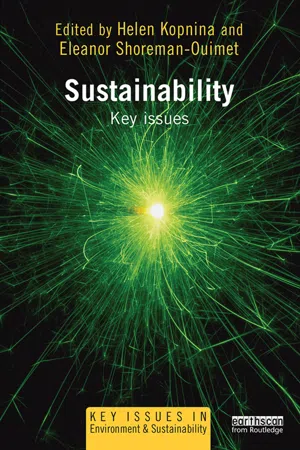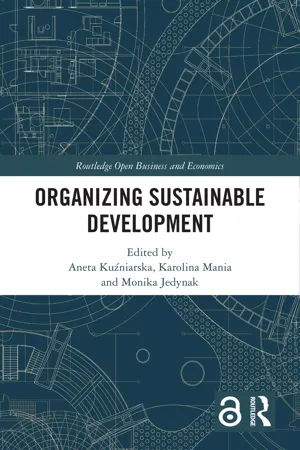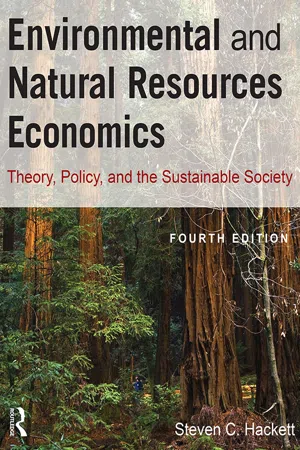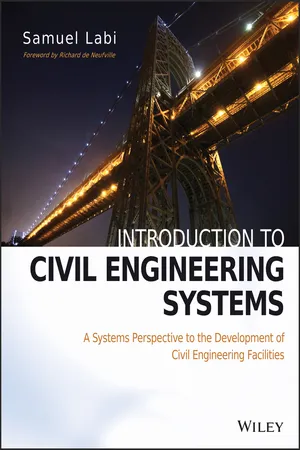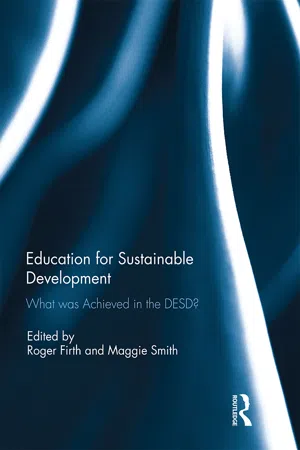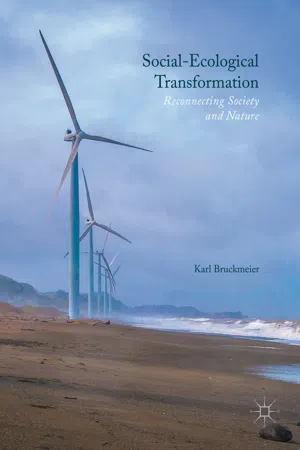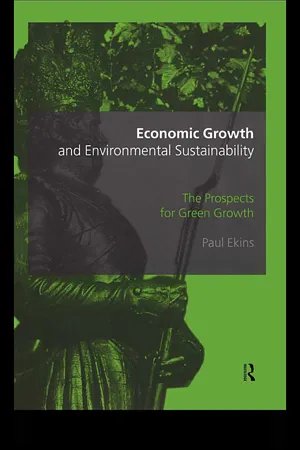Geography
Sustainability
Sustainability refers to the responsible use of resources to meet the needs of the present without compromising the ability of future generations to meet their own needs. It involves balancing economic, social, and environmental considerations to ensure long-term well-being. In geography, sustainability is a key concept for understanding the interactions between human societies and the natural environment.
Written by Perlego with AI-assistance
Related key terms
11 Key excerpts on "Sustainability"
- Joachim H. Becker, Sven Pastoors, Ulrich Scholz(Authors)
- 2017(Publication Date)
- Tectum(Publisher)
4 describes the ability of a community, organisation or a company to operate in such a way that they also have the capacity to endure into the future. This does not only apply to every individual and every company, but also for humanity as a whole. In the long-term, the current global community cannot live at the expense of future generations. This also includes individual communities not being allowed to consume in such a way that they burden people in other regions of the world.Even though the first calls for the sustainable use of the natural resources were already made in antiquity, the efficient use of natural resources did not play a role for a long time (Rogall 2012, p. 29-31). The term “Sustainability” itself derives initially from the forestry sector in the 18th century.5The discussion about sustainable development originates from the global economic crisis of the 1970s. This crisis made it clear that we are endangering our own livelihood through the exploitation of natural resources. Today, Sustainability is an economic concept. Economic, ecological and social developments must not be separated from one another or played off against each other: no permanent economic and social progress without an intact environment – no intact environment without economic and social well-being.Sustainability is a cross-sectional task, because it affects all the areas of our lives. Its implementation is a global challenge. Due to globalisation, the social, economic and ecological consequences can be felt worldwide. Environmental and development problems cannot be solved by one country alone; hence they must be solved together in close collaboration. From this, the three dimensions of Sustainability can be deduced:- eBook - ePub
- Simon Catling, Tessa Willy(Authors)
- 2018(Publication Date)
- SAGE Publications Ltd(Publisher)
In the UK, Sustainability was prominent in geography after 2000 (DfEE/QCA, 1999). However, its importance was reduced after 2010. Indeed, the word ‘Sustainability’ was not mentioned at all in the revision of England’s primary national curriculum at that time (DfE, 2013). That Sustainability is missing in any country’s curriculum guidance or requirements does not preclude or prevent it from being included by a school and taught. Sustainability emphasises using resources so that they are self-renewing or carefully replenished, and with working finite resources so as to manage a smooth transition from declining resources to new, hopefully renewable and regenerative resources. Sources for energy are an example, such as the move from coal and oil sources to solar, wind and tidal sources. How we use resources and live is a matter of future Sustainability. This concerns the distribution of resources between and their use by people, with the goal of enabling all to live comfortably rather than a few to live very well while the majority live less well. As well as studying what is happening, geography reflects on the practical and ethical uses and misuses of the environment, and of people and their places and communities. Examining environmental impact and Sustainability involves concern with social and environmental justice.The term ‘sustainable development’ is frequently used and it can seem contradictory to talk about Sustainability as maintaining the status quo while implying suggestions of expansion and advancement. Commonly, we perceive development to mean economic and lifestyle progress and so mean economic development, and this has been manifest in developing technology to improve material possessions and using increasing amounts of energy and material resources to do so. However, we have come to understand development in much broader terms to include environmental development and social well-being. It is important to remember that sustainable development must involve environmental Sustainability; it implies the need to steward renewable and regenerative resources such that when we use them they remain available in future, as well as to provide improving environments for people’s lives. One point that the Brundtland Commission made in 1987 (United Nations, 1987) implied that we will develop alternative, renewable sources to replace finite resources. Yet, this perspective has been viewed as highly problematic and difficult to achieve. We need to explore and help children who will live in this future environment to perceive environmental Sustainability and sustainable development in terms of improvement, not simply materially but for the benefit of our environment, societies and communities, as environmentally friendly growth (Huckle and Martin, 2001). Only then can we have real Sustainability globally and understand that we are here for good and not just for the weekend (Patten, 2000). Martin and Owens state that Sustainability is less a product than a process: thinking about ourselves, thinking about others and using our knowledge to make responsible decisions and actions - eBook - ePub
Exploring Sustainable Development
Geographical Perspectives
- Martin Purvis, Alan Grainger(Authors)
- 2013(Publication Date)
- Routledge(Publisher)
Studies of spatial inequality have thus encouraged attempts to develop a more sophisticated understanding of the geographical form of social and economic systems, and of socio-economic processes as an influence upon the production and reproduction of space. Particular attention has been paid to the ordering of space under capitalism, leading to a recognition that spatial inequality – often characterized as uneven development – is an integral feature of capitalist development (Smith, 1990). Such attempts to understand the causes of social and spatial inequality highlight the extent to which local conditions are shaped by the wider interplay of economic and political forces at a national and international level. It follows that measures to secure positive change must often be directed towards points in time and space that are far removed from the most obvious symptoms of social injustice and environmental stress. Crucially, too, the argument that development in one region is necessarily predicated on underdevelopment elsewhere has profound implications for aspirations to secure greater intra-generational and inter-generational equity. It helps to explain why change is often so controversial and contested, which is a reality that is not always confronted in current economic theories of sustainable development.Thinking geographically
Geography has a long record of studying both the environmental impacts and Sustainability of human activity, and the equity with which the costs and benefits of development are distributed. In this sense, geographical attention to what is now termed sustainable development long predates discussions inspired by the 1987 Brundtland Report or the ensuing 1992 UN Conference on Environment and Development (UNCED) in Rio de Janeiro. Geography’s record of applied work – in fields ranging from environmental management to access to welfare services – is also consistent with the desire to improve both the human condition and the health of the environment that motivates the study of sustainable development (for different perspectives on applied geography, see Burton and Kates, 1965; Pacione, 1999a; Peet, 1977; Stamp, 1963) Moreover, thinking geographically – which involves attention to the needs and circumstances of particular communities; to the spatial patterning of human activity; to the relationships that connect the human and environmental spheres; and to the links between individual localities and wider systems – has the potential to enhance and extend existing attempts to understand the theory and practice of sustainable development. In a context that demands a broad-based and integrative understanding, geography’s intellectual diversity and capacity for synthesis constitute genuine strengths. Geography does not have answers for all of the questions posed by sustainable development; but, arguably, it has the right attitude to advance knowledge in this field. The chapter now turns, therefore, to consider the attempts already made to foster explicit engagement between geography and sustainable development. - eBook - ePub
Sustainability
Key Issues
- Helen Kopnina, Eleanor Shoreman-Ouimet(Authors)
- 2015(Publication Date)
- Routledge(Publisher)
Part I Defining SustainabilityPassage contains an image
Introduction The emergence and development of Sustainability
Helen Kopnina and Eleanor Shoreman-OuimetWhat is Sustainability?
There are many different uses of the term Sustainability as well as its derivatives, such as social Sustainability, environmental Sustainability, sustainable development, sustainable living, sustainable future, and many others. Literally, the word Sustainability means the capacity to support, maintain or endure; it can indicate both a goal and a process. In ecology, Sustainability describes how biological systems remain diverse, robust, resilient and productive over time, a necessary precondition for the well-being of humans and other species. As the environment and social equality became increasingly important as a world issue, Sustainability was adopted as a common political goal.The concept of Sustainability the way most of us use it today emerged in the 1960s in response to concern about environmental degradation. This degradation was seen by some to result from the consequences of industrial development, increase in consumption and population growth and by others as poor resource management or the result of underdevelopment and poverty. Sustainability was linked to ethical concerns, typically involving a commitment to justice between generations involving issues such as equal distribution of wealth, working conditions and human rights, and possibly between humans and nonhumans, as discussed in chapters of Robert Garner, Holmes Rolston III and Haydn Washington.We can distinguish between different types of Sustainability, for example between social (in terms of promoting equality, health, human rights), economic (in terms of sustaining people’s welfare, equitable division of resources) and environmental (in terms of sustaining nature or natural resources for humans and for nonhuman species) Sustainability, as well as combinations of them. The study of Sustainability involves multidisciplinary approaches, anthropology, political ecology, philosophy and ethics and environmental science. This type of multidisciplinary combination enables us to explore this new form of institutionalized Sustainability science in a neoliberal age of environmental knowledge production and Sustainability practice. - eBook - ePub
- Aneta Kuźniarska, Karolina Mania, Monika Jedynak(Authors)
- 2023(Publication Date)
- Routledge(Publisher)
However, this definition was broadened – as if in response to the Brundtland Commission report (WCED, 1987) – by including bio-geophysical aspects in the publication of the World Bank (Holdren et al., 1995), where the term “biophysical Sustainability” is defined as strengthening the integrity of systems supporting life on Earth. The author also pointed out that both biological diversity and the bio-geochemical integrity of the biosphere (proper use and conservation of natural resources – land, water and air) are important. The topic of Sustainability was widely discussed at the beginning of the 21st century and was taken up by many organisations (e.g. OECD, 2001). Reading these studies shows that the central role in them is played not by the economy (and further growth), but by the environment or harmony with it – as the Boulding essay indicates. Here, ecological economics provided support, pointing out that the interdependence of natural ecosystems and the economy should be considered, as well as the dimensions of time and space (Xepapadeas, 2008, pp. 3258–3271). This is especially important when we think about intergenerational justice and the ability of the environment to regenerate, including irreversible changes, for example the prospective loss of almost a million species that are currently endangered (IPBES, 2019, p. XVI); and on spatial justice, on the strength of which some species-rich areas or reservoirs should be particularly well-protected (and extended) and others, sensitive to climate change – where the life and health of people and other species inhabiting them are endangered, for example by hurricanes and floods in the countries of the Global South – should be strengthened and prepared for weather shocks - eBook - ePub
Environmental and Natural Resources Economics
Theory, Policy, and the Sustainable Society
- Steven Hackett, Sahan T. M. Dissanayake(Authors)
- 2014(Publication Date)
- Routledge(Publisher)
Sustainability perspective promotes broader and more equitable participation in policy decisions, while repudiating unsustainable consumption and production. Reform must address the relationship between failures of economic and social justice on the one hand and environmental degradation on the other. Sustainability represents a vision of the future with deep roots that can be traced back to a variety of primary origins, including the Iroquois Confederation. The Iroquois developed a standard of judging decisions based on the well-being of tribal people seven generations into the future. Many cultures over the course of human history have recognized the need for harmony between their economy, community, and environment. what is new is an articulation of these ideas in the context of the globalization of technology, information, economics, and environmental crises.The Sustainability movement calls for a more sophisticated and inclusive view of development and well-being that explicitly takes into account ecological health, natural resource stocks, vibrant and just communities, and democratic processes. Sustainability has come to mean different things to different people, and by encompassing so many things there is the potential for its meaning to dissipate or to become appropriated. We will develop a definition of Sustainability in this chapter that can be used as a standard for evaluating social, economic, and environmental policies.How is Sustainability viewed within the discipline of economics? As we will discuss in detail in Chapter 14 , traditional economic growth theorists see Sustainability as an issue of intergenerational equity and as a constraint on economic growth; they also see constructed capital as substitutable for natural capital. Somewhat more recently, but in the same vein, Arrow et al. (2004) view Sustainability as an economic modeling problem and interpret Sustainability to mean that social welfare does not decline over time. other economists are much less traditional in their views. For example, Daly and Cobb (1989) draw upon Aristotle’s distinction between chrematistics and oikonomia to illustrate the difference between the mainstream of contemporary economic thought and the emerging Sustainability economics.Chrematistics can be thought of as the process of managing economic affairs in such a way as to maximize the value of the decision maker’s financial wealth as measured in money. Oikonomia refers to household management, which in Greek times included a broad array of activities, a relatively larger number of people than we associate with modern households, and elements of a multi-generational perspective. Accordingly, Daly and Cobb argue that oikonomia differs from chrematistics in that (1) it takes a longer-term view, (2) it focuses attention on the well-being of the household community as opposed to a more individualistic perspective on financial wealth accumulation, and (3) it places a larger emphasis on use value, while chrematistics is more narrowly focused on money exchange values. Thus, oikonomia emphasizes the broader focus and longer time horizon that is more consistent with the Sustainability perspective than is the prevailing economic focus on financial wealth, which is embodied in the concept of chrematistics. - eBook - ePub
Sustainability
If It's Everything, Is It Nothing?
- Heather M. Farley, Zachary A. Smith(Authors)
- 2020(Publication Date)
- Routledge(Publisher)
sustainable in a concept’s title does not mean that the results of the approach will actually produce sustained environmental health or mitigation of ecosystem service loss. Maximum sustainable yield has become a popular buzzword that implies resource management designed to support the principles of sustainable development. In fact, what we find is that in many cases the broadly defined approach ignores the interconnectedness of ecosystems and allows for detrimental practices that disturb the stability of natural systems rather than supporting and sustaining those systems. Definitions of Sustainability and the associated approaches to Sustainability must not be so broad that they are subject to co-optation and are relegated to the status of mere rhetoric. A definition of Sustainability must provide enough precision to ensure that practices do not become a free-for-all of greenwashing and faux Sustainability.The problems with maximum sustainable yield suggest that a definition of Sustainability should be based on systems thinking. That is, Sustainability requires that we understand the ripple effect of development and policy decisions as well as the interconnected nature of environmental, social, and economic systems both within and between system types. Many practices are meant to support the Sustainability mission of an institution or government but do not ultimately accomplish much when viewed from a cradle-to-grave perspective or when considering the impacts between systems. Compostable utensils, plates, or containers, for example, are a useful option when you or your city has a robust composting program, but otherwise the materials simply end up in landfills and biodegrade alongside all the other waste products from the community. Many companies and schools have implemented the use of compostable materials in their Sustainability plans but have not considered whether the act truly accomplishes anything for the community or environment. This is one of many such examples that demonstrates the need not simply to assign projects or approaches without understanding the greater implications of the project. Another way of saying this is that vertical and horizontal integration are not central to the most common uses of Sustainability. Sustainability requires that we consider the impacts and overlaps of policies and actions between different levels of implementation (local, regional, national) and across different domains (economic, environmental, and social). Definitions of Sustainability and sustainable development - eBook - ePub
Introduction to Civil Engineering Systems
A Systems Perspective to the Development of Civil Engineering Facilities
- Samuel Labi(Author)
- 2014(Publication Date)
- Wiley(Publisher)
Temporal Certain elements of Sustainability are more applicable to the short term than to the long term. For example, increased noise from an airport construction project can be short term, while the land-use impacts of the noise from the airport's operations, such as changes in property values, are felt over a long period of time. Also, the construction of a new hydroelectric plant may result in immediate impacts (e.g., reliability of power supply, flooding of nearby villages) while longer term impacts such as increased business productivity due to reduction of electrical power outages, will take some time to be realized.Spatial Spatial scopes, which could be categorized as global, regional, and local, include specific scopes such as statewide, countywide, citywide, areawide, corridorwide, or within the immediate vicinity of the system in question.Stakeholder The perspectives of various affected entities and stakeholders, as to what constitutes Sustainability, may differ. For example, with regard to the economic element of Sustainability, the system owner may be primarily interested in financial solvency through user fees while the system users may view a system with high user fees as unsustainable.28.7 Systems Concepts in Sustainability Modeling
Sustainability considerations are very consistent with the concept of systems thinking. As we discussed in Chapter 2, a system can be defined as a construct of different elements that, when combined, produce results not achievable by the elements acting individually. Similarly, planet Earth or any part thereof could be considered as a system, not as a multicomponent entity but as a complex interrelated and interdependent dynamic whole (Khisty et al., 2012). In this section, we will discuss two key concepts in systems analysis where Sustainability considerations are applicable. - eBook - ePub
Education for Sustainable Development
What was achieved in the DESD?
- Roger Firth, Maggie Smith(Authors)
- 2018(Publication Date)
- Routledge(Publisher)
Sustainability is increasingly important as a concept within education, particularly in the light of the United Nations Decade of Education for Sustainable Development (2005–14: UNESCO, 2005), and in 2006 the Sustainable Schools Framework was launched in England which encouraged schools to ‘prepare young people for a lifetime of sustainable living’ (Department of Children, Schools and Families, 2006). Education for Sustainable Development (ESD) became part of the National Curriculum in England in 2000 and the revised 2008 National Curriculum in England placed significant emphasis on ESD, both within discrete subjects and through one of the seven (now abandoned) cross-curricular dimensions: global dimension and sustainable development. Within the Geography Programme of Study specifically, there is clear recognition of the significant role geography can play in educating students about Sustainability as it states that, ‘geography inspires pupils to become global citizens by exploring their own place in the world, their values and their responsibilities to other people, to the environment and to the Sustainability of the planet’ (QCA, 2007, p. 101). However, while government publications and policy seem to stress the importance of ESD, and despite the fact that we are approaching the end of the Decade of Education for Sustainable Development (DESD), its impact on students’ understandings and behaviours appears to remain relatively unexplored. Research I previously undertook with Year 8 (12- and 13-year-old) geography students found that they appeared to be aware of the ‘three pillars’ of Sustainability (environment, society and economy), but many had only a superficial appreciation of the concepts themselves (Walshe, 2008). Further, the students expressed a desire to better understand the relevance of Sustainability to their own lives. With this in mind, and within the context of the DESD, I undertook research for this study based on two key questions: what are a class of Year 10 (14- and 15-year-old) geography students’ understandings of Sustainability; and how do these understandings develop over the course of an academic year? Within this paper, and given the aims of the UN DESD, I more specifically aim to explore the extent to which student understandings of Sustainability relate to the DESD strategic perspectives to inform education and learning for sustainable development, as well as to consider the ways that students engage with the concept of Sustainability as being relevant to their lives.Sustainability and Education for Sustainable Development
The concept of sustainable development was first conceived at the 1972 United Nations Conference on the Human Environment in Stockholm when, although it was not specifically referred to, governments agreed that development and the environment should be managed in a mutually beneficial manner (SDC, 2009). One of the first and certainly the most widely used definition in schools was constructed by the World Commission on Environment and Development (WCED) in 1987 and was a product of a report entitled ‘Our Common Future’. This produced the ‘Brundtland definition’ that describes sustainable development as progress which, ‘… meets the needs of the present without compromising the ability of future generations to meet their own needs’ (WCED, 1987, p. 43). Although since then there have been countless definitions of the concept as it has spread across various sectors and disciplines (Lipscombe, 2008), and many authors still consider sustainable development to be a complex and contested concept (e.g. McKeown, 2002), it is the Brundtland definition that is most commonly given in school geography textbooks within England, from those supporting students at Key Stage 3 (aged 11–14), through to those aimed at Advanced Level students (aged 16–19). This is perhaps understandable given both the origins of the definition, as well as its relative simplicity, but does this simplicity belie the complexity of sustainable development? For example, Kilinc and Aydin (2011) argue that it does not explain the nature of ‘needs’ or how they would be met. It is possibly the case that teachers (and their students) find it useful to have a straight-forward definition of a complex, abstract concept such as sustainable development, but I would argue that this should be a basis for discussion, rather than an end point when considering Sustainability with young people in schools. - eBook - ePub
Social-Ecological Transformation
Reconnecting Society and Nature
- Karl Bruckmeier(Author)
- 2016(Publication Date)
- Palgrave Macmillan(Publisher)
© The Editor(s) (if applicable) and The Author(s) 2016 Karl Bruckmeier Social-Ecological Transformation 10.1057/978-1-137-43828-7_4Begin Abstract4. Sustainability in Social-Ecological Perspective
End AbstractKarl Bruckmeier 1(1) Higher School of Economics, National Research University, Gothenburg, SwedenThe social-ecological theory of nature and society, discussed in Chaps. 2 and 3 , has as one aim to clarify the nature of the process called sustainable development. Sustainability is discussed at two levels:- Of a discourse in which the meanings of the notion of the term are continually disputed, interpreted, and re-interpreted in their social, political, economic, and ecological meanings in a scientific and a political discourse.
- Of a process of change of the practices of natural resource use in modern society that has started with local, national, and international political decisions in the early 1990s.
To specify and clarify, by way of theoretical interpretation, the forms, and the courses, and the duration of this process of change are attempted in this chapter. In this interpretation, sustainable development appears as integrated social and ecological process to maintain the functions and processes of societal and ecological systems in a long-term perspective that is (inexactly) described as intergenerational solidarity of resource use. To achieve this clarification about the nature and perspective of the Sustainability process, it is, however, necessary to go through the discourse first, showing how this perspective of an integrated social-ecological process is perceived, reflected, and discussed. This is done in four steps of review:- Reconstructing difficulties and failures in the prior Sustainability discourse
- Discussing a renewal and broadening of the discourse where the nature of sustainable development as process of change of resource use is specified as a transformation of industrial society
- Evaluating interdisciplinary analyses of sustainable development in search of a theory of transformation
- Integrating theoretical Sustainability analyses
- eBook - ePub
Economic Growth and Environmental Sustainability
The Prospects for Green Growth
- Paul Ekins(Author)
- 2002(Publication Date)
- Routledge(Publisher)
Finally it may be noted that these environmental space calculations are heavily dependent on projected population growth. In particular, countries with stable populations will have their environmental space reduced over time by population growth elsewhere. Such a variation is likely to be politically controversial and to militate against policy makers’ adoption of the environmental space methodology and targets. This problem would be eased by the adoption of a reference year (e.g. 1990) for the calculation of a country’s environmental space, which would then be unchanged by future population change. Then, of course, countries with growing populations would find their environmental space being progressively reduced, while those with stable populations would not. This would give an incentive to curb population growth.Table 4.2 Calculations of global environmental space and necessary reductions from four European studiesNotes:a Source: FOE (1995:102 (Table 6.1 ))b Source: Sachs et al. (1998:45 (Table 3.1 ))c Source: Buitenkamp et al. (1993:89)d Source: McLaren et al. (1998:241 (Table C.1))e The Table cited actually says this is the required reduction in energy use, but the detailed calculation of p. 89 makes it clear that it is CO2 that is intendedf Agricultural land requirements for minimum dietary needs, i.e. not sustainable environmental space4.3 S USTAINABILITY PRINCIPLES AND STANDARDS
4.3.1 Deriving principles of environmental Sustainability
UnSustainability with regard to a human way of life in general has been earlier defined as a situation in which, because of effects on biota or the human way itself, cannot with any assurance be projected to continue into the future. Environmental unSustainability comes about when environmental functions which are important for human ways of life and welfare are not sustained or put at risk. Given the uncertainties involved in matters of Sustainability, and the possibility of irreversibility, and of the incidence of very large costs, once environmental functions have been lost, the question of risk is crucial, not least because risk, through insurance premiums for example, incurs present real, as well as hypothetical future, costs.The simultaneous coincidence of uncertainty, irreversibility and possible large costs has long been recognised as an important consideration for environmental policy. Ciriacy-Wantrup’s (1952) classic work prefigured many of the current concerns of Sustainability with his development of the concept of ‘the safe minimum standard’.
Index pages curate the most relevant extracts from our library of academic textbooks. They’ve been created using an in-house natural language model (NLM), each adding context and meaning to key research topics.
